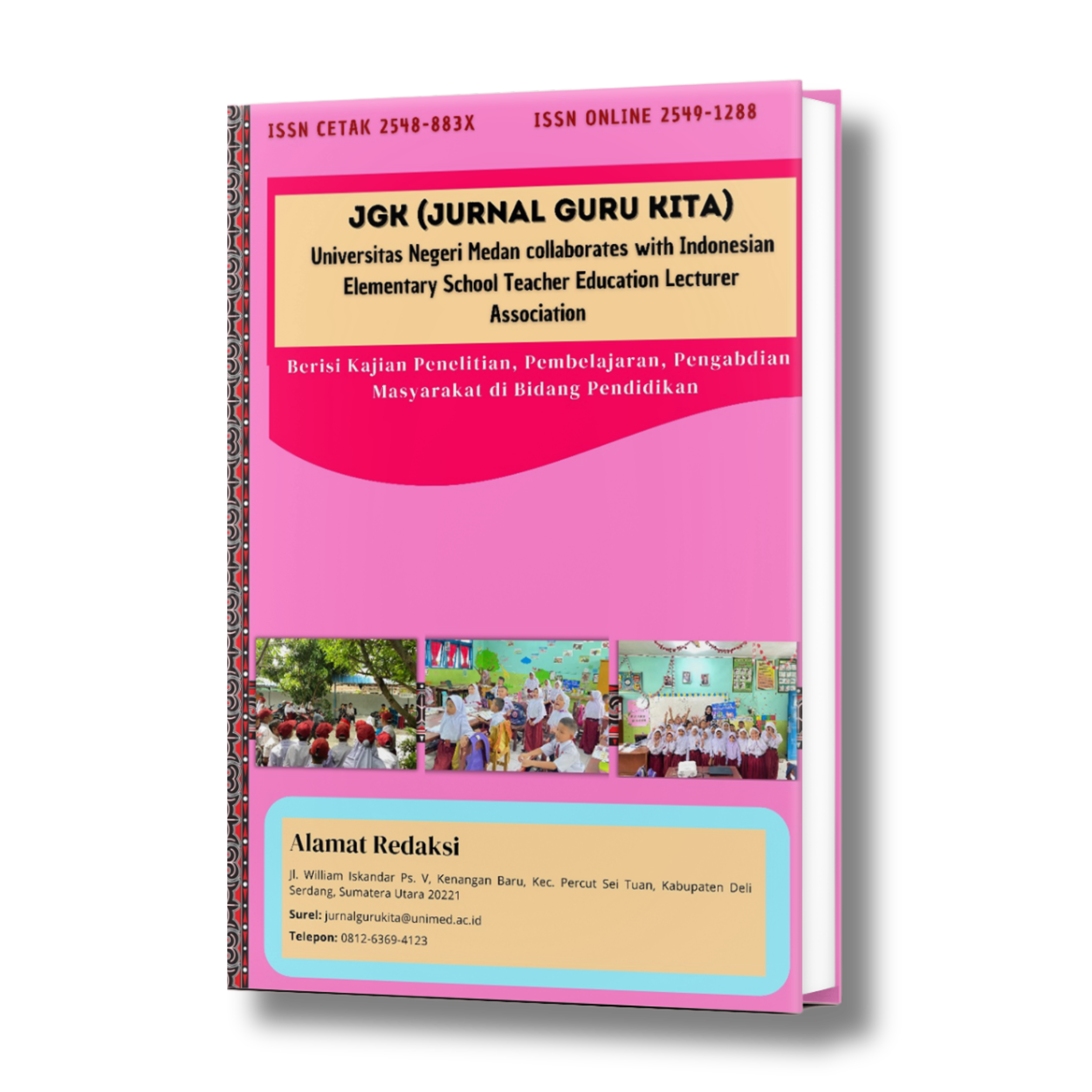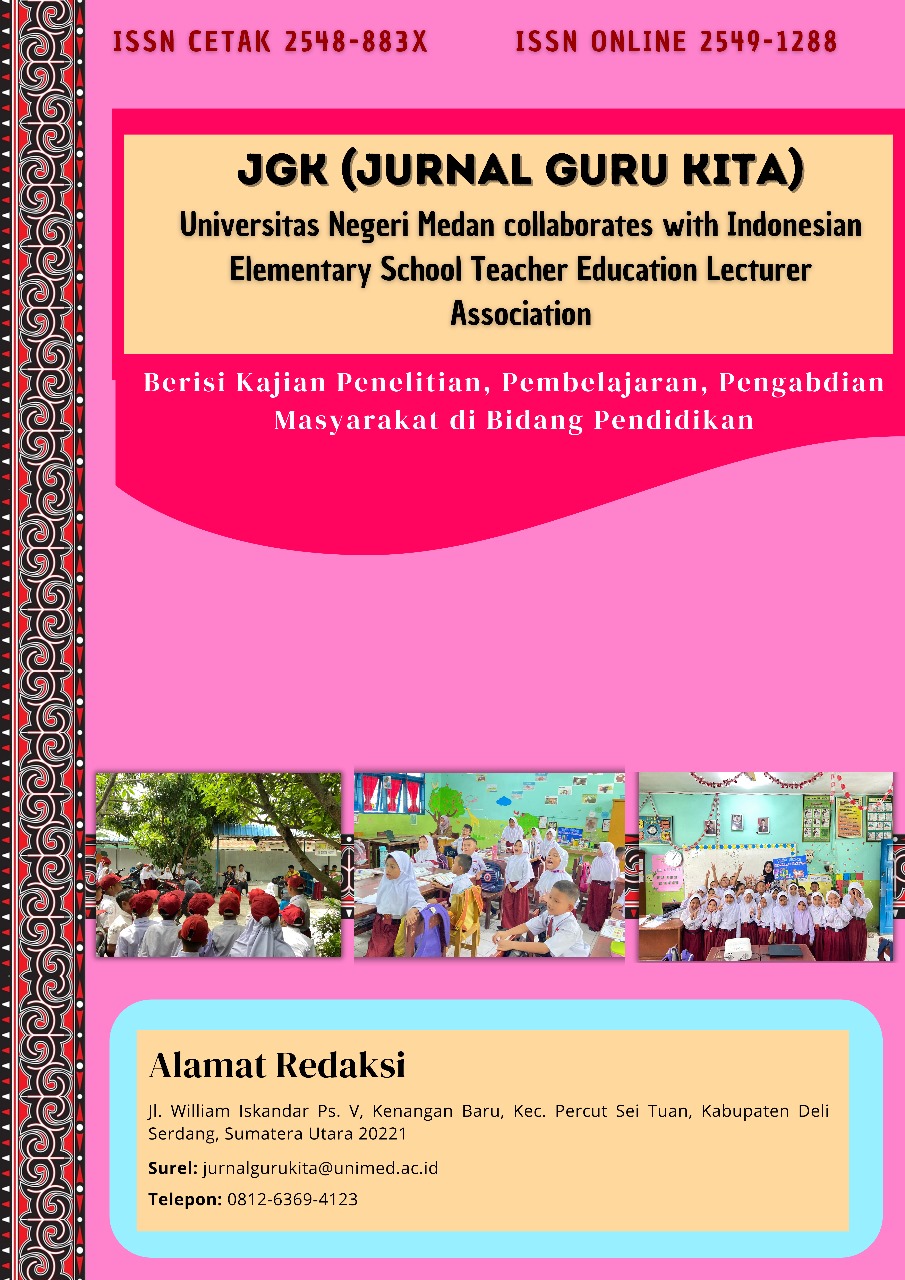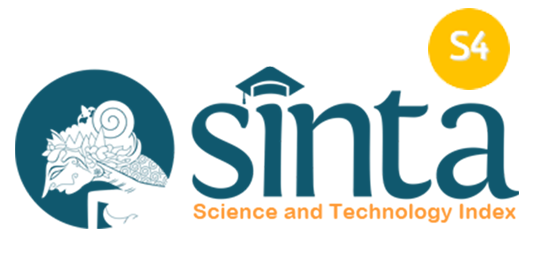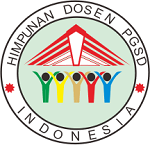Analisis Penggunaan Media Pembelajaran Power Point terhadap Kegiatan Belajar Peserta Didik
DOI:
https://doi.org/10.24114/jgk.v9i3.69440Keywords:
Analisis Kebutuhan, PowerPoint, Pembelajaran TematikAbstract
Penelitian ini bertujuan untuk menganalisis penggunaan media pembelajaran PowerPoint terhadap kegiatan belajar siswa sekolah dasar, khususnya pada pembelajaran tematik kelas IV SD Negeri Kota Metro. Fokus penelitian adalah mendeskripsikan peran PowerPoint sebagai media interaktif, hambatan yang muncul, serta kontribusinya terhadap keterlibatan siswa. Penelitian menggunakan pendekatan kualitatif dengan metode naratif, karena sesuai untuk menggambarkan pengalaman dan realitas lapangan secara rinci. Subjek penelitian adalah 20 siswa kelas IV dan guru kelas. Data dikumpulkan melalui survei, wawancara, dan observasi, kemudian dianalisis secara deskriptif naratif. Hasil penelitian menunjukkan bahwa PowerPoint mampu meningkatkan fokus, motivasi, dan partisipasi siswa. Siswa lebih antusias, aktif bertanya, dan terlibat dalam diskusi karena materi disajikan dengan kombinasi teks, gambar, audio, video, dan animasi. Guru juga terbantu dalam menjelaskan konsep yang abstrak menjadi lebih konkret melalui visualisasi yang menarik. Namun demikian, terdapat kelemahan seperti keterbatasan interaktivitas, potensi ketergantungan pada tampilan visual, serta risiko kelebihan informasi jika slide dirancang terlalu padat. PowerPoint merupakan media pembelajaran yang efektif, praktis, dan fleksibel dalam meningkatkan kualitas pembelajaran tematik. Agar lebih optimal, guru perlu merancang slide dengan tepat dan memadukannya dengan metode interaktif lain, sehingga kegiatan belajar tidak hanya menarik tetapi juga bermakna.References
Abbasi, M., Shirazi, M., Torkmandi, H., Homayoon, S., & Abdi, M. (2023). Impact of teaching, learning, and assessment of medical law on cognitive, affective and psychomotor skills of medical students: a systematic review. BMC Medical Education, 23(1), 703. https://doi.org/10.1186/s12909-023-04695-2
Ahmad, M., & Wilkins, S. (2025). Purposive sampling in qualitative research: a framework for the entire journey. Quality & Quantity, 59(2), 1461–1479. https://doi.org/10.1007/s11135-024-02022-5
Aifan, H. (2022). Implementing a project-based collaborative learning approach using PowerPoint to improve students’ 21st- century skills. E-Learning and Digital Media, 19(3), 258–273. https://doi.org/10.1177/20427530211030642
Barut Tugtekin, E., & Dursun, O. O. (2022). Effect of animated and interactive video variations on learners’ motivation in distance Education. Education and Information Technologies, 27(3), 3247–3276. https://doi.org/10.1007/s10639-021-10735-5
Cash, P., Isaksson, O., Maier, A., & Summers, J. (2022). Sampling in design research: Eight key considerations. Design Studies, 78, 101077. https://doi.org/10.1016/j.destud.2021.101077
Darling-Hammond, L., Schachner, A. C. W., Wojcikiewicz, S. K., & Flook, L. (2024). Educating teachers to enact the science of learning and development. Applied Developmental Science, 28(1), 1–21. https://doi.org/10.1080/10888691.2022.2130506
Daryanes, F., Darmadi, D., Fikri, K., Sayuti, I., Rusandi, M. A., & Situmorang, D. D. B. (2023). The development of articulate storyline interactive learning media based on case methods to train student’s problem-solving ability. Heliyon, 9(4).
Dash, M. (2023). Cone of Experience. In AECT at 100 (pp. 136–144). BRILL. https://doi.org/10.1163/9789004682580_010
Gamage, K. A. A., Dehideniya, D., & Ekanayake, S. Y. (2021). The role of personal values in learning approaches and student achievements. Behavioral Sciences, 11(7), 102.
Jin, Y. Q., Lin, C.-L., Zhao, Q., Yu, S.-W., & Su, Y.-S. (2021). A Study on Traditional Teaching Method Transferring to E-Learning Under the Covid-19 Pandemic: From Chinese Students’ Perspectives. Frontiers in Psychology, 12. https://doi.org/10.3389/fpsyg.2021.632787
Keshavarz, H., Fallahnia, S., & Hamdi, F. (2022). How university instructors apply the design principles for electronic courses: a comparative study based on Richard Mayer’s model on multimedia learning. The International Journal of Information and Learning Technology, 39(4), 319–339. https://doi.org/10.1108/IJILT-11-2021-0173
Khoa, B. T., Hung, B. P., & Brahmi, M. H. (2023). Qualitative research in social sciences: data collection, data analysis and report writing. International Journal of Public Sector Performance Management, 12(1/2), 187–209. https://doi.org/10.1504/IJPSPM.2023.132247
Kim Pham, C., Chong, S. L., & Wan, R. (2023). A Phenomenographic Research Study of Students’ Conceptions of Silence in Face-to-Face English as a Foreign Language Learning. Sage Open, 13(4). https://doi.org/10.1177/21582440231216343
Lazić, Z., Đorđević, A., & Gazizulina, A. (2021). Improvement of Quality of Higher Education Institutions as a Basis for Improvement of Quality of Life. Sustainability, 13(8), 4149. https://doi.org/10.3390/su13084149
León, S. P., & García-Martínez, I. (2021). Impact of the provision of PowerPoint slides on learning. Computers & Education, 173, 104283. https://doi.org/10.1016/j.compedu.2021.104283
Lindenberg, D. (2025). Logico-semantic relations between spoken text and slides’ visual elements in student presentations conducted online in the English as a Foreign Language context. Visual Communication, 24(2), 319–345. https://doi.org/10.1177/14703572231180215
Pratama, Y., Pratiwi, W. R., & Saehu, A. (2025). Students’ Experiences with English Movies for Vocabulary Development and Motivation Based on Learning Style. Journal of Education of English as a Foreign Language, 8(1), 21–46. https://doi.org/10.21776/ub.educafl.2025.008.01.02
Rahim, F. R., Sari, S. Y., Sundari, P. D., Aulia, F., & Fauza, N. (2022). Interactive design of physics learning media: The role of teachers and students in a teaching innovation. Journal of Physics: Conference Series, 2309(1), 012075. https://doi.org/10.1088/1742-6596/2309/1/012075
Reinita, Mifthahul Jannah, & Ferdian Admil Sandika. (2024). Interactive PowerPoint Media on Thematic Learning in Primary School. Jurnal Edutech Undiksha, 11(2), 269–276. https://doi.org/10.23887/jeu.v11i2.60259
Rozali, D., & Ramadan, Z. H. (2021). Learning Heat and Its Transfer with Power Point Learning Media for Grade V Students of Elementary School. International Journal of Elementary Education, 5(2), 98. https://doi.org/10.23887/ijee.v5i2.35493
Szymkowiak, A., Melović, B., Dabić, M., Jeganathan, K., & Kundi, G. S. (2021). Information technology and Gen Z: The role of teachers, the internet, and technology in the education of young people. Technology in Society, 65, 101565. https://doi.org/10.1016/j.techsoc.2021.101565
Yu, B., & Zadorozhnyy, A. (2022). Developing students’ linguistic and digital literacy skills through the use of multimedia presentations. ReCALL, 34(1), 95–109. https://doi.org/10.1017/S0958344021000136
Zhao, X., & Wang, D. (2025). Unpacking the Antecedents of Boredom and Its Impact on University Learners’ Engagement in Languages Other Than English: A Qualitative Study in the Distance Online Learning Context. International Journal of Applied Linguistics, 35(3), 1121–1133. https://doi.org/10.1111/ijal.12680
Zhussupova, R., & Shadiev, R. (2023). Digital storytelling to facilitate academic public speaking skills: case study in culturally diverse multilingual classroom. Journal of Computers in Education, 10(3), 499–526. https://doi.org/10.1007/s40692-023-00259-x
Downloads
Published
How to Cite
Issue
Section
License
Copyright (c) 2025 Vinka Berliana Kesumawijaya, Syafira Dwi Syakina, Triana Anggun Saputri, Supriyadi Supriyadi, Jody Setya Hermawan

This work is licensed under a Creative Commons Attribution-ShareAlike 4.0 International License.
Authors published with the JGK (Jurnal Guru Kita) agree to the following terms:
- Authors retain copyright and grant the journal the right of first publication with the work simultaneously licensed under a Creative Commons Attribution License (CC BY-SA 4.0) that allows others to share the work with an acknowledgment of the work's authorship and initial publication in this journal.
- Authors are able to enter into separate, additional contractual arrangements for the non-exclusive distribution of the journal's published version of the work (e.g., post it to an institutional repository or publish it in a book), with an acknowledgment of its initial publication in this journal.
- Authors are permitted and encouraged to post their work online (e.g., in institutional repositories or on their website) prior to and during the submission process, as it can lead to productive exchanges, as well as earlier and greater citation of published work. (See The Effect of Open Access)
























